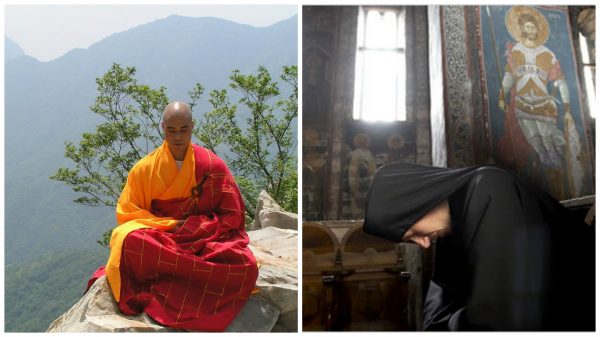Below is part of my answer to the question, “What is the difference between the peace Buddhists talk about and the peace that Christ gives?”
Having never experienced Buddhist peace, I can only speculate based on what I have learned about Buddhism from reading. The goal of Buddhist meditation, again speaking as a fool who does not really know, is to realize that everything is nothing, and to be absorbed into the One, which is everything, and be released from the cycle of pleasure and pain. Some Buddhist meditation techniques seem similar to Hesychast techniques. Some of the language describing the experience seems similar (e.g. peace and light or enlightenment).
I think this is because, whether Christian or Buddhist, the human psyche is the same. So on one level, the peace would be the same. However, Buddhist peace, again, as far as I understand it, is a peace in nothingness. The peace of Christ is a peace with content, personal content. Buddhist peace comes from realizing that nothing is real and so nothing matters except merging into cosmic oneness. Christ’s peace is Christ’s personal presence in a very real world, a world that matters.
Of course this is what makes things difficult for zealous folks like me. If the world really matters, I figure I need to get out there and do something. However, I fail miserably because I am working from my own strength, not in union with Christ. But this is not a loss, for in accepting my weakness, I learn to know and depend on Christ. I gain humility. Then, amazingly, somehow comforted by the peace of Christ’s presence, my few words and weak actions in the world are sometimes filled with the Holy Spirit and power to accomplish good, or at least some good, in the world.
For Christians, suffering is real. In fact, fundamental to the Christian reality is the Cross. We join Christ on the Cross, or on the cross of our personal encounter with sin and the results of sin. We are crucified by the suffering we are unable to relieve, and especially by the suffering that we actively, though perhaps unintentionally, inflict on others. Yet somehow it is in this very suffering because of suffering that we encounter the Suffering One, passing through suffering to death (a kind of peace–perhaps like the Buddhist peace in nothingness, I don’t know).
But it doesn’t stop there. There is also a kind of resurrection, a kind of participation on earth of the Life of the age to come. There is a Life in the Spirit that is full of peace, joy, love, etc. and this Life does good in the world. Regretfully, it seems few Christians actually experience this–and perhaps I have only experienced brief moments of this Life, or perhaps I have only caught brief glimpses of it, but not yet really experienced it. I, too often, run away from the suffering and death before the resurrection arrives. But to be completely honest I have to say that in some small ways I have experienced this resurrected Life, and I have seen this Life in others too.
Christian peace and resurrected Life are real–they are not just in someone’s head. It is existential, if you like. But it is not something that is easily or automatically attained. It is freely given, but learning how to receive it takes a lifetime. I think this is exactly what St. Seraphim of Sarov meant when he admonished people to acquire the Holy Spirit.




















